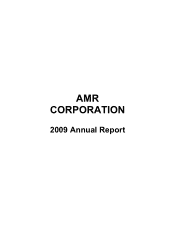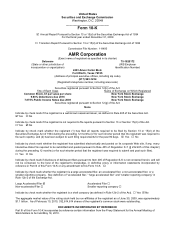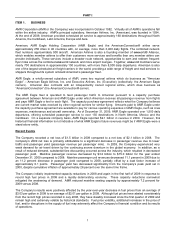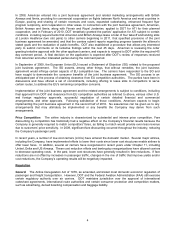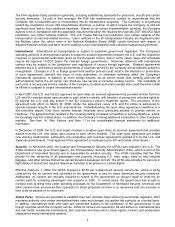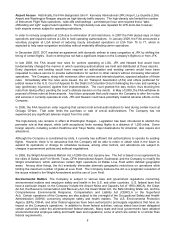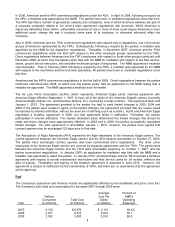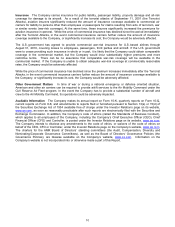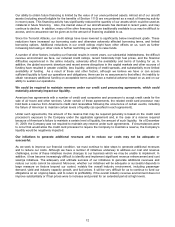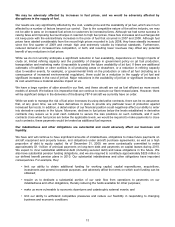American Airlines 2009 Annual Report Download - page 7
Download and view the complete annual report
Please find page 7 of the 2009 American Airlines annual report below. You can navigate through the pages in the report by either clicking on the pages listed below, or by using the keyword search tool below to find specific information within the annual report.
4
In 2008, American entered into a joint business agreement and related marketing arrangements with British
Airways and Iberia, providing for commercial cooperation on flights between North America and most countries in
Europe, pooling and sharing of certain revenues and costs, expanded codesharing, enhanced frequent flyer
program reciprocity, and cooperation in other areas. In connection with the joint business agreement, American,
British Airways and Iberia, along with Finnair and Royal Jordanian, applied to DOT for ATI for their planned
cooperation, and in February of 2010, DOT tentatively granted the parties’ application for ATI subject to certain
conditions including requirements that American and British Airways lease a total of four takeoff and landing slots
at London Heathrow (two slot pairs) to other carriers beginning in 2011, that specified provisions of the joint
business agreement be amended, and that the carriers submit reports regarding progress towards the alliance’s
stated goals and the realization of public benefits. DOT also established a procedure that allows any interested
party to submit comments on its tentative findings within the next 45 days. American is reviewing the order
granting tentative approval with the other applicant carriers, and expects to respond to DOT within the required 45
day comment period. A final decision on the application is expected after DOT’s review of responses received
from American and other interested parties during the comment period.
In September of 2009, the European Union (EU) issued a Statement of Objection (SO) related to the proposed
joint business agreement. The SO asserts, among other things, that without remedies, the joint business
agreement would infringe certain aspects of EU competition law. The carriers have responded to the SO and
have sought to demonstrate the consumer benefits of the joint business agreement. The SO process is an
anticipated part of the process of obtaining clearance from EU competition authorities. The parties have been in
discussions and have offered a set of commitments, including offering to lease slots to competitors to serve
certain routes, to address the EU's remaining competition concerns.
Implementation of the joint business agreement and the related arrangements is subject to conditions, including
final approval from DOT and clearance from EU competition authorities as referred to above, various other U.S.
and foreign regulatory approvals, successful negotiation of certain detailed financial and commercial
arrangements, and other approvals. Following satisfaction of those conditions, American expects to begin
implementing the joint business agreement in the second half of 2010. No assurances can be given as to any
arrangements that may ultimately be implemented or any benefits the Company may derive from such
arrangements.
Price Competition The airline industry is characterized by substantial and intense price competition. Fare
discounting by competitors has historically had a negative effect on the Company’s financial results because the
Company is generally required to match competitors' fares, as failing to match would provide even less revenue
due to customers’ price sensitivity. In 2009, significant fare discounting occurred throughout the industry, reducing
the Company’s passenger yield.
In recent years, a number of low-cost carriers (LCCs) have entered the domestic market. Several major airlines,
including the Company, have implemented efforts to lower their costs since lower cost structures enable airlines to
offer lower fares. In addition, several air carriers have reorganized in recent years under Chapter 11, including
United, Delta and US Airways. These cost reduction efforts and bankruptcy reorganizations have allowed carriers
to decrease operating costs. In the past, lower cost structures have generally resulted in fare reductions. If fare
reductions are not offset by increases in passenger traffic, changes in the mix of traffic that improve yields and/or
cost reductions, the Company’s operating results will be negatively impacted.
Regulation
General The Airline Deregulation Act of 1978, as amended, eliminated most domestic economic regulation of
passenger and freight transportation. However, DOT and the Federal Aviation Administration (FAA) still exercise
certain regulatory authority over air carriers. DOT maintains jurisdiction over the approval of international
codeshare agreements, international route authorities and certain consumer protection and competition matters,
such as advertising, denied boarding compensation and baggage liability.

